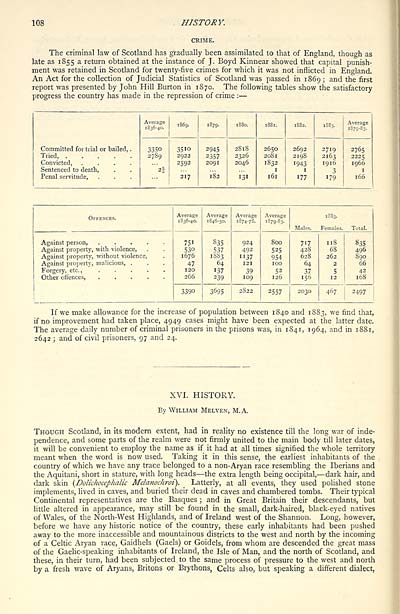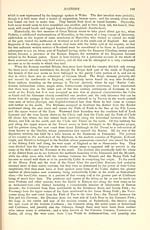Ordnance gazetteer of Scotland > Volume 6
(436) Page 108
Download files
Complete book:
Individual page:
Thumbnail gallery: Grid view | List view

108
HISTORY.
CRIME.
The criminal law of Scotland has gradually been assimilated to that of England, though as
late as 1855 a return obtained at the instance of J. Boyd Kinnear showed that capital punish-
ment was retained in Scotland for twenty-five crimes for which it was not inflicted in England.
An Act for the collection of Judicial Statistics of Scotland was passed in 1869; and the first
report was presented by John Hill Burton in 1870. The following tables show the satisfactory
progress the country has made in the repression of crime : —
Committed for trial or bailed, .
Average
1S36-40.
1869.
1879.
1880.
1SS1.
1882.
1883.
Average
1879-83.
3350
351°
2945
28l8
2650
2692
2719
2765
Tried, .....
27S9
2922
2357
2326
20Sl
219S
2163
2225
Convicted, ....
2592
209I
2046
1S32
1943
I916
1966
Sentenced to death,
2|
I
I
I
Penal servitude,
217
182
131
l6l
177
179
166
Offences.
Average
1836-40.
Average
1846-50.
Average
1S74-78.
Average
1S79-83.
1SS3.
Males. Females. Total.
Against person, .....
Against property, with violence,
Against property, without violence,
Against property, malicious, .
Forgery, etc., .....
Other offences,
7Si
53°
1676
47
120
266
S35
537
1883
64
137
239
924
492
"37
121
39
109
800
525
954
100
52
126
717
428
628
64
37
I5S
IlS
68
262
2
5
12
835
496
S90
66
42
168
339°
369s
2822
2557
2030
467
2497
If we make allowance for the increase of population between 1840 and 1883, we find that,
if no improvement had taken place, 4949 cases might have been expected at the latter date.
The average daily number of criminal prisoners in the prisons was, in 1841, 1964, and in 1881,
2642 ; and of civil prisoners, 97 and 24.
XVI. HISTORY.
By William Melven, M.A.
Though Scotland, in its modern extent, had in reality no existence till the long war of inde-
pendence, and some parts of the realm were not firmly united to the main body till later dates,
it will be convenient to employ the name as if it had at all times signified the whole territory
meant when the word is now used. Taking it in this sense, the earliest inhabitants of the
country of which we have any trace belonged to a non-Aryan race resembling the Iberians and
the Aquitani, short in stature, with long heads — the extra length being occipital, — dark hair, and
dark skin {Dolichocephalic Melanochroi). Latterly, at all events, they used polished stone
implements, lived in caves, and buried their dead in caves and chambered tombs. Their typical
Continental representatives are the Basques ; and in Great Britain their descendants, but
little altered in appearance, may still be found in the small, dark-haired, black-eyed natives
of Wales, of the North-West Highlands, and of Ireland west of the Shannon. Long, however,
before we have any historic notice of the country, these early inhabitants had been pushed
away to the more inaccessible and mountainous districts to the west and north by the incoming
of a Celtic Aryan race, Gaidhels (Gaels) or Goidels, from whom are descended the great mass
of the Gaelic-speaking inhabitants of Ireland, the Isle of Man, and the north of Scotland, and
these, in their turn, had been subjected to the same process of pressure to the west and north
by a fresh wave of Aryans, Britons or Brythons, Celts also, but speaking a different dialect,
HISTORY.
CRIME.
The criminal law of Scotland has gradually been assimilated to that of England, though as
late as 1855 a return obtained at the instance of J. Boyd Kinnear showed that capital punish-
ment was retained in Scotland for twenty-five crimes for which it was not inflicted in England.
An Act for the collection of Judicial Statistics of Scotland was passed in 1869; and the first
report was presented by John Hill Burton in 1870. The following tables show the satisfactory
progress the country has made in the repression of crime : —
Committed for trial or bailed, .
Average
1S36-40.
1869.
1879.
1880.
1SS1.
1882.
1883.
Average
1879-83.
3350
351°
2945
28l8
2650
2692
2719
2765
Tried, .....
27S9
2922
2357
2326
20Sl
219S
2163
2225
Convicted, ....
2592
209I
2046
1S32
1943
I916
1966
Sentenced to death,
2|
I
I
I
Penal servitude,
217
182
131
l6l
177
179
166
Offences.
Average
1836-40.
Average
1846-50.
Average
1S74-78.
Average
1S79-83.
1SS3.
Males. Females. Total.
Against person, .....
Against property, with violence,
Against property, without violence,
Against property, malicious, .
Forgery, etc., .....
Other offences,
7Si
53°
1676
47
120
266
S35
537
1883
64
137
239
924
492
"37
121
39
109
800
525
954
100
52
126
717
428
628
64
37
I5S
IlS
68
262
2
5
12
835
496
S90
66
42
168
339°
369s
2822
2557
2030
467
2497
If we make allowance for the increase of population between 1840 and 1883, we find that,
if no improvement had taken place, 4949 cases might have been expected at the latter date.
The average daily number of criminal prisoners in the prisons was, in 1841, 1964, and in 1881,
2642 ; and of civil prisoners, 97 and 24.
XVI. HISTORY.
By William Melven, M.A.
Though Scotland, in its modern extent, had in reality no existence till the long war of inde-
pendence, and some parts of the realm were not firmly united to the main body till later dates,
it will be convenient to employ the name as if it had at all times signified the whole territory
meant when the word is now used. Taking it in this sense, the earliest inhabitants of the
country of which we have any trace belonged to a non-Aryan race resembling the Iberians and
the Aquitani, short in stature, with long heads — the extra length being occipital, — dark hair, and
dark skin {Dolichocephalic Melanochroi). Latterly, at all events, they used polished stone
implements, lived in caves, and buried their dead in caves and chambered tombs. Their typical
Continental representatives are the Basques ; and in Great Britain their descendants, but
little altered in appearance, may still be found in the small, dark-haired, black-eyed natives
of Wales, of the North-West Highlands, and of Ireland west of the Shannon. Long, however,
before we have any historic notice of the country, these early inhabitants had been pushed
away to the more inaccessible and mountainous districts to the west and north by the incoming
of a Celtic Aryan race, Gaidhels (Gaels) or Goidels, from whom are descended the great mass
of the Gaelic-speaking inhabitants of Ireland, the Isle of Man, and the north of Scotland, and
these, in their turn, had been subjected to the same process of pressure to the west and north
by a fresh wave of Aryans, Britons or Brythons, Celts also, but speaking a different dialect,
Set display mode to: Large image | Transcription
Images and transcriptions on this page, including medium image downloads, may be used under the Creative Commons Attribution 4.0 International Licence unless otherwise stated. ![]()
| Gazetteers of Scotland, 1803-1901 > Ordnance gazetteer of Scotland > Volume 6 > (436) Page 108 |
|---|
| Permanent URL | https://digital.nls.uk/97392834 |
|---|
| Attribution and copyright: |
|
|---|---|

